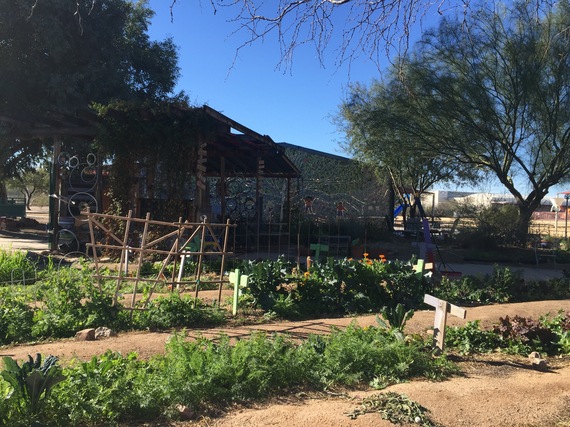The 'Be Kind' mural at Borton Elementary School in Tucson, AZ. Photo credit: Carrie Brennan.
Visit my son's elementary school at 8:00 a.m. any morning of the year and you'll find a festive spirit in the air. In the courtyard, where the entire school gathers to start the day, there is music playing and children are dancing and jumping rope. Slowly this outdoor space at the heart of the small campus fills with more children, teachers, and parents who linger to be a part of the daily gathering.
A class of students in charge of the 'morning meeting' that week organizes themselves on the low stage; they turn off the stereo music, check the mic, line up, and begin singing. The audience joins in, then the pledge of allegiance, then announcements and distribution of "kindness notes." Lastly, the principal shares her daily welcome. The school day officially begins.
School-wide activities like this are key to fostering a happy, healthy, cohesive learning environment--what we in the field of education call "positive school culture." This is an intangible but profoundly important aspect of our work that has been under threat over the last decade of high-stakes testing. Under No Child Left Behind, schools were pressured to maximize 'seat time' and 'time on task.' Anything that took students away from the specific business of rote learning could be viewed as a distraction.
Fortunately, it appears we are at a turning point with the Every Student Succeeds Act (ESSA) signed into law by President Obama in December, which mandates states to include at least one non-academic measure of school quality in their accountability system. This new requirement promises to shine a much-needed spotlight on school culture. This is good news for teachers, principals, parents, and most importantly, for students.
Consider all that occurs in the short span of ten minutes at the start of each day at my son's school. Students participate in a community that values play, song, student leadership, kindness, and recognition. They practice listening skills and being good audience members. They experience a sense of belonging. The whole community sees itself represented: students, teachers, school leaders, and parents gathered together. This is vital learning that is well worth the time spent - and will never show up on a standardized test.
While some might dismiss school culture as being on the periphery compared with other educational priorities, it is actually of central importance. In environments where safety, trust, and relationships are valued, students are more likely to be focused on their learning, to take risks, and to challenge themselves. When the adults in a school know the students as individuals, they can provide a more personalized approach to teaching. Schools become less an institution and more a community.
How can you take the pulse of a school's culture? Walk into any school and look for the following:
• Are the adults in the building welcoming to outsiders? Do they seem to be friendly toward one another? Do they know the parents and who their children are? Do you see the principal? How do teachers communicate with students as they move through the building- what is the tone, the message?
• Do the students generally appear to be acting purposefully and appropriately? Do they welcome visitors? Do they seem confident and comfortable in their surroundings? Are they interacting with one another? Are they happy?
• Is the physical environment clean and cared for? Does it feel safe? Is student learning visible? Are student projects on display? Are classrooms visible from the halls? Are there community spaces for the school to gather? Is there outdoor space to play? A garden to tend?
Borton's school garden, chicken coop, and outdoor classroom. Photo credit: Carrie Brennan.
Schools with a healthy school culture tend to be mission-focused schools with a shared sense of purpose. The mission shows up in school-wide activities that are done well and consistently, like a daily morning meeting. Other commonalities include: a principal who is visible and accessible, routine time for teacher collaboration, activities for students before and after school, a discipline system rooted in restorative justice, and regular events for parents to participate in.
They are also schools that value the notion that learning takes place beyond the classroom, and recognizes that all adults in the school are teachers for all students. There is a collective responsibility for the well-being and advancement of all of the young people in the school community.
On that note, we can all engage with our neighborhood schools, even if we're not parents. Attend events, volunteer, take a tour, watch sports games. By being present and getting involved, we become part of the community and help create the culture.
In a speech to teachers in Philadelphia in January, acting Secretary of Education John B. King described the new ESSA legislation as an opportunity for a "'reset' in the national conversation about schools and the path forward." In this renewed conversation about teaching and learning, will the talk be about more than testing? There is hope as the pendulum swings.


You need to be a member of School Leadership 2.0 to add comments!
Join School Leadership 2.0